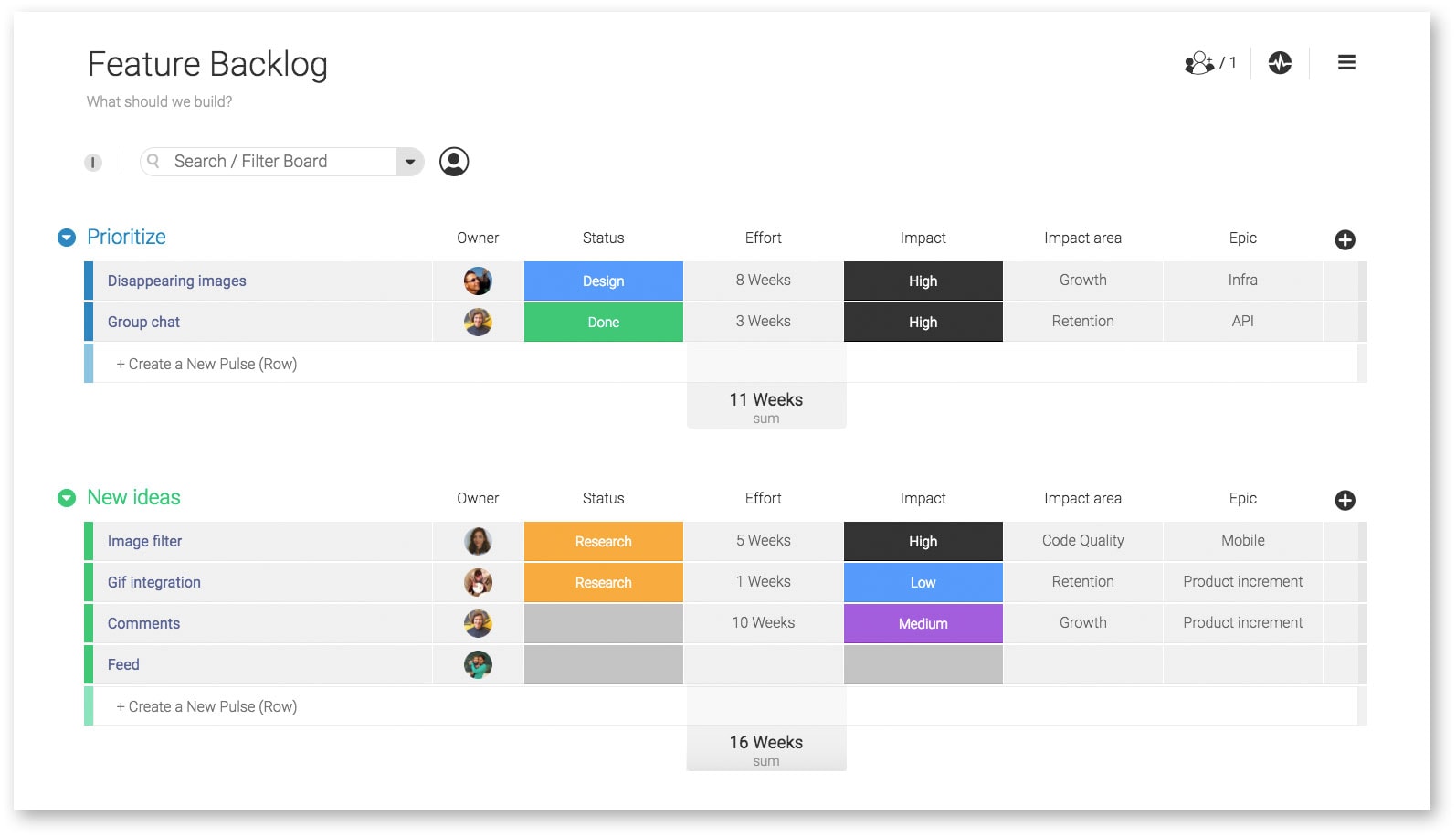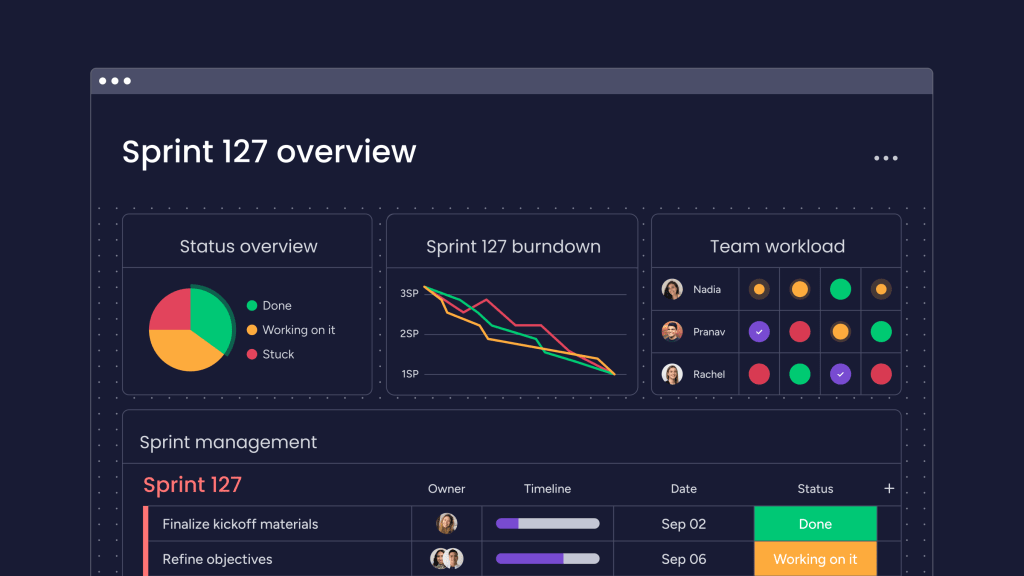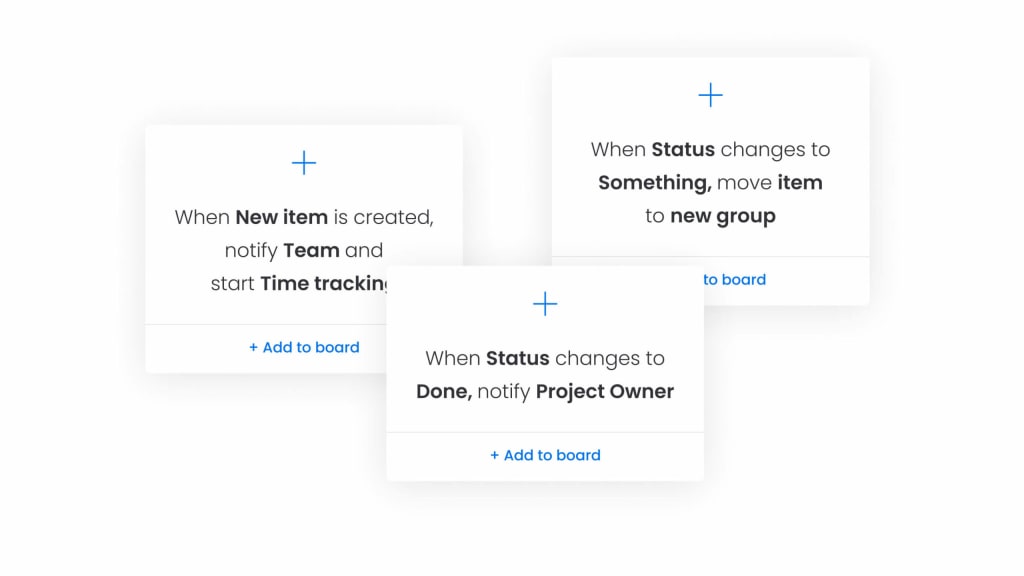A successful product takes meticulous planning. With so many small tasks making up a greater product launch, tackling them all in due time can be challenging without a proper roadmap. For teams using Agile project management, there are built-in solutions for tracking all the different tasks and features that go into product development.
The product backlog is one of those solutions. A good product backlog will make product release planning run smoothly by outlining what your team plans to tackle next. By being intentional with how team members prioritize and spend time on tasks, products can be delivered on time and on budget while meeting stakeholder expectations.
In this blog post, we’ll cover the ins and outs of tackling your product backlog, including what they’re for, who uses them, how to create your own, and software like monday dev that makes tracking it all quick and painless.
What is a product backlog?

In the development world, a product backlog includes new features, fixes, or updates needed for a specific project. It acts as a sort of dynamic “to-do list” of tasks and features to be implemented. The tasks on a product backlog are outlined in a product roadmap, which serves as a detailed plan for a development team that helps guide their work and prioritize tasks. While a product roadmap offers a strategic direction, a product backlog aims to turn goals into actionable items to be executed.
Product backlogs are key aspects in Agile workflows like Scrum and are usually managed or owned by the product owner of a team. The product owner will ensure that items on a backlog are prioritized by urgency or importance and get actioned in due time.
In sprint planning, items from a backlog are selected to be included based on a team’s capacity or focus. That said, not all items in a product backlog will get worked on if they’re not urgent matters, but the list will get continuously refined and updated as projects go through new iterations and as priorities shift.
Who uses the product backlog?
Anyone building any type of product can use a product backlog, however, they’re most often used by Agile teams, especially developers, to better focus their time on urgent tasks. There are different team members who use a product backlog on a regular basis:
- Product owner: As the name implies, the product owner owns the backlog and is responsible for the product’s overall success. They’ll maintain a birds-eye view over the backlog and are the ones to curate, prioritize, and refine items based on factors like feedback, risks, market demands, and value.
- Developers: The development team, including engineers, testers, and designers, will refer to the backlog to see what work needs to be done and to better plan upcoming sprints.
- Stakeholders: In addition to teams working directly on a product, stakeholders such as customers, executives, or even end users can access a product backlog in order to offer feedback and understand a product’s direction based on upcoming changes.
If a team has a Scrum Master, then they’ll likely also have a hand in the backlog, but not as significantly as the Product Owner. The Scrum Master’s focus should be on the project itself and not the details of the product.
What does a product backlog contain?
A product backlog typically includes things like new features, feature updates, bug fixes, technical debt, and more. However, product backlog varies from one team to the next. In general it includes all the tasks related to a project, from small to big. Let’s take a more detailed look at some of the items that a product backlog can contain:
- Features (user stories): These are new functions to be added to the product, often referred to as different types of stories or epics, which are more complex.
- Technical debt: Some work is essential to keeping the product maintainable, secure, and up-to-date, and this is often referred to as ‘technical debt.’
- Bugs: Defects and bugs are often found by end-users or support reps and often require a high-priority timeline for fixing.
- Research: Research is instrumental in knowing whether concepts or features can be implemented so it’s often recorded on the backlog so time can be allocated as necessary.
- Feature improvements: Existing features require ongoing maintenance and development, especially as the product evolves.
- Design change ideas: Not all features are tangible or bring utility to the end-user, some are purely cosmetic and provide a fresh aesthetic.
- UX issues: User experience is paramount to creating a product that’s intuitive and easy to use.
- Infrastructure changes: Code sometimes needs an overhaul to stay relevant and integrations get switched and require retooling.
What’s the difference between a product backlog and a sprint backlog?

If you’re new to Scrum, then you might be wondering the difference between the two. Product backlogs and sprint backlogs are similar, but ultimately, the difference comes down to timing:
- A product backlog is a vessel that holds what the team may eventually do. It’s work that’s prioritized but not necessarily tied to a commitment or a particular sprint yet.
- A sprint backlog is a vessel that holds what the team is doing within a planned sprint. Ideally, the sprint backlog remains static throughout the entire sprint since at this point you’ve committed to delivering these specific features or bug fixes.
As you can see, the product backlog is generally much larger than the sprint backlog because it’s all-encompassing. You’ll find short-term feature requests, long-term product ideas, and more in the product backlog.
The sprint backlog is much more granular than that because each task was carefully selected and prioritized for the sprint you’re about to undertake. The sprint backlog comes directly from the product backlog, it can’t exist without it.
5 best practices for product backlog management
Creating a product backlog isn’t difficult, but to do it right and make the most of it, there are some best practices that will steer you in the right direction. Below are 5 tips for better product backlog management that will ensure all your sprints are set up for success.
1. Let the product roadmap guide you
Before you start thinking about filling up your backlog, you need to be in the right frame of mind. Reviewing your product strategy is crucial if you want to prioritize the right sprints and individual tasks. The best way to do this is to consistently refer to your product roadmap to help you maintain and prioritize items on your backlog based on the goals you initially set.
2. Get everything down
Between feature requests, bugs, and maintenance, you’ll likely have a towering list of potential items to tackle. The best thing you can do is perform a brain dump into the product backlog and even get other team members in on the process. Prioritization will come later, so don’t get bogged down in the details.
Consider the project journey, high-level features, major releases, and your launch timeline. Capture smaller features as well, any bugs you know, and various internal and external feature requests. In this stage, you can also include ideas from users, employees, engineers, developers, and other stakeholders.
3. Put everything in its place
Now that you have a master list, it’s time to organize each backlog item. There are multiple ways to organize your product backlog, such as classifying smaller backlog items as stories and larger ones as epics.
You can also group work by initiatives and themes. Here’s a quick description of each:
- Themes are larger focus areas that often span an entire department or organization
- Initiatives are comprehensive collections of epics that ultimately drive toward shared goals
- Epics are larger bodies of work that will be broken down into multiple smaller tasks, called stories
- User stories are shorter requests or requirements written from the end user’s perspective
No matter what you decide, it should be consistent throughout your backlog.
4. Start the prioritization process
Armed with a master list of organized tasks to tackle, now it’s time to perform your first backlog grooming session to add detail and prioritize the backlog items.
The top of the backlog is where the high-priority items go. That way, they’re front and center and don’t require any digging when planning your next sprint. The level of detail for each item will often decrease the further down the list you go.
Some factors to consider when prioritizing items include:
- Customer expectations
- Development effort
- Feature complexity
- Overall reach of the features
- Potential changes to the product roadmap
5. Schedule your backlog review
Prioritizing your backlog once isn’t enough. The product backlog is a living, breathing vehicle that requires constant maintenance and upkeep. Otherwise, the tasks grow stale, lack depth, and lose prioritization.
This ongoing process of prioritizing items is often referred to as “backlog grooming” or “backlog refinement” within the Agile methodology. As a cross-functional team, it’s imperative that during this regular process, you carefully review items through the lens of the end user, asking yourself: “What backlog items add the most value to the customer?”
Managing your product backlog with monday dev
Keeping up with a Scrum product backlog is potentially cumbersome or time-consuming if you don’t have the right set of tools. Thankfully, monday dev makes it simple to not only set up your first product backlog but to keep it up to par at all times.
Chock-full of features, templates, and boards to compliment Agile processes like product backlogs, monday dev is the ideal tool to track and collaborate on all the items you need to action. Here’s a look at some of the best monday dev features that will help you create a flexible yet reliable backlog.
Feature backlog template

If you’re ready to dive right into building your own product backlog, get started quickly with a feature backlog template made exactly for this purpose. Fitted with columns to set priority, status, reach, sub features, and more, you can simply plug in your items and features to the backlog template and start organizing and actioning them straight away.
Multiple work views

When it comes to Agile methodologies, flexibility is the name of the game. With monday dev, you can picture your work in over 27 different ways, including Kanban boards, Gantt charts, Timeline, Calendar, Workload, and others, giving you complete control over how you visualize items on your product backlog.
Automations for everything

monday dev allows you to build custom automations, which can save you a lot of time while working on a product backlog. You can automate prioritization by setting parameters based on an item’s metrics in a board, or set yourself automated reminders for reviewing your backlog periodically.
Try monday devGetting started with your product backlog
Tackling your product backlog can seem daunting, especially if it’s complex, disorganized, or not prioritized. By following the steps outlined above and implementing a solution like monday dev, you’ll be able to approach all the items and features in your backlog with ease.
Not only is monday dev ideal for managing your backlog, but it provides a framework for many other Agile methodologies, like sprints, feedback loops, processes that require ongoing communication and collaboration, and more. With a free two-week trial, you can test out how monday dev can make your product backlog tracking simpler and see how it also fits your other project needs.

